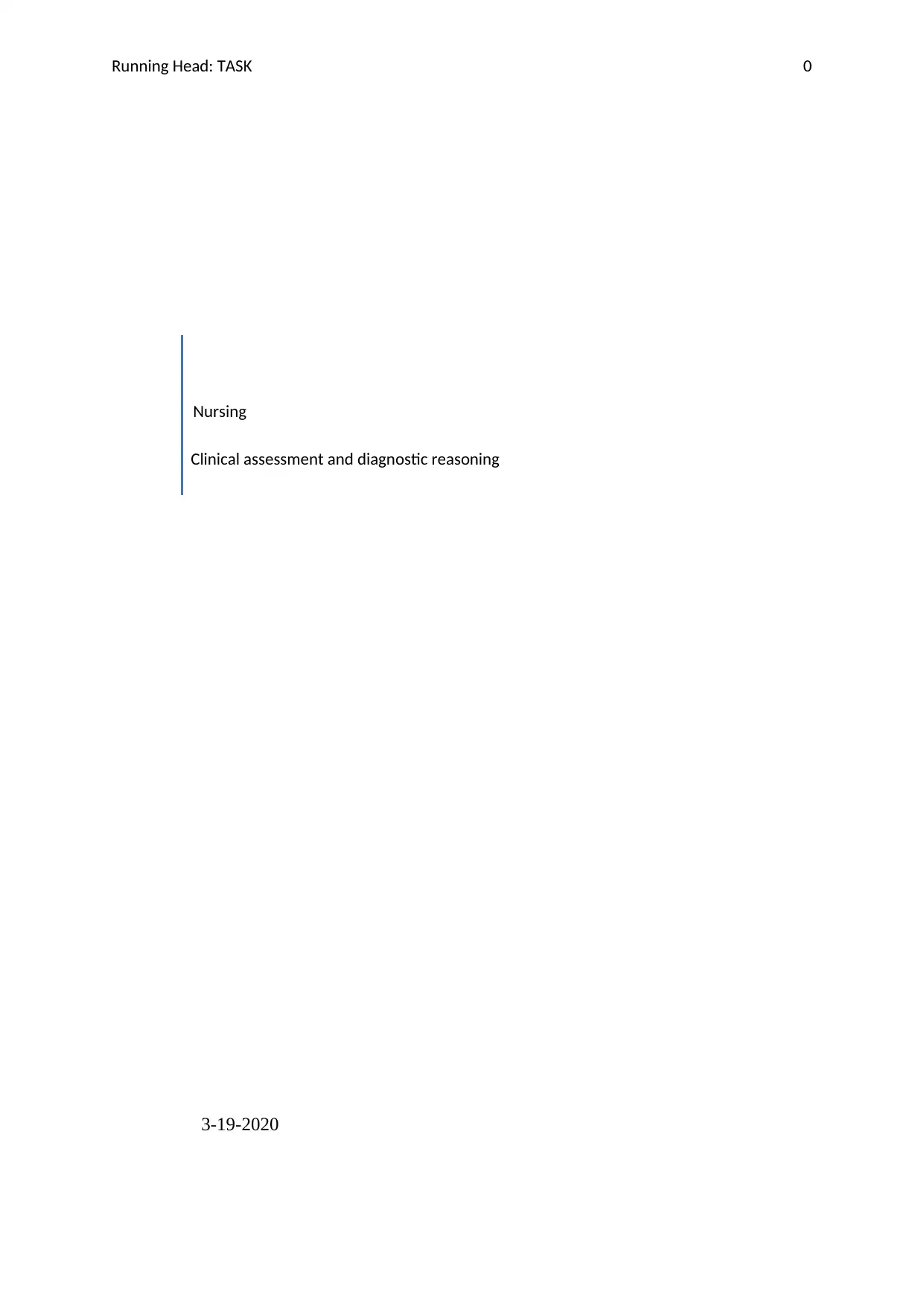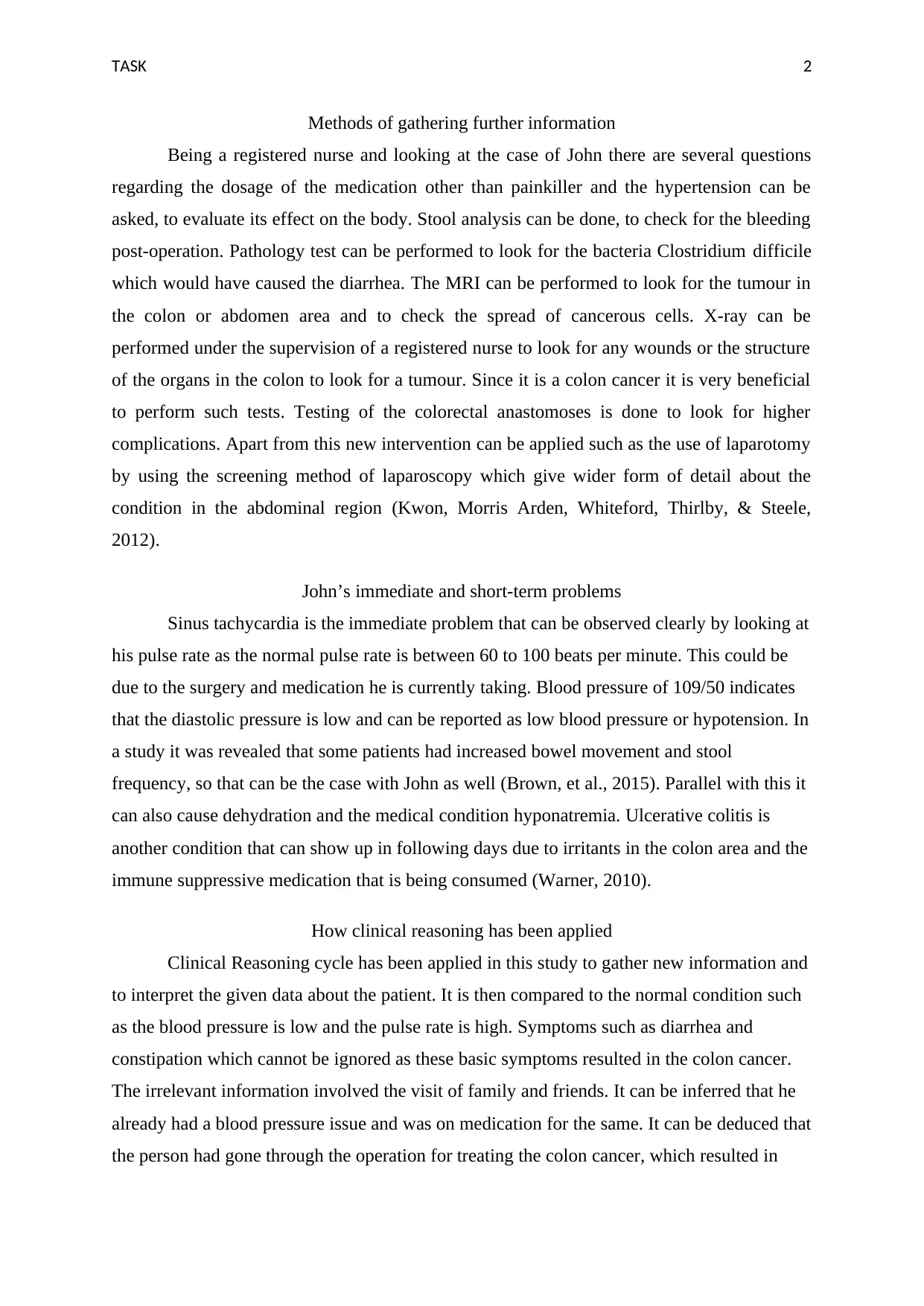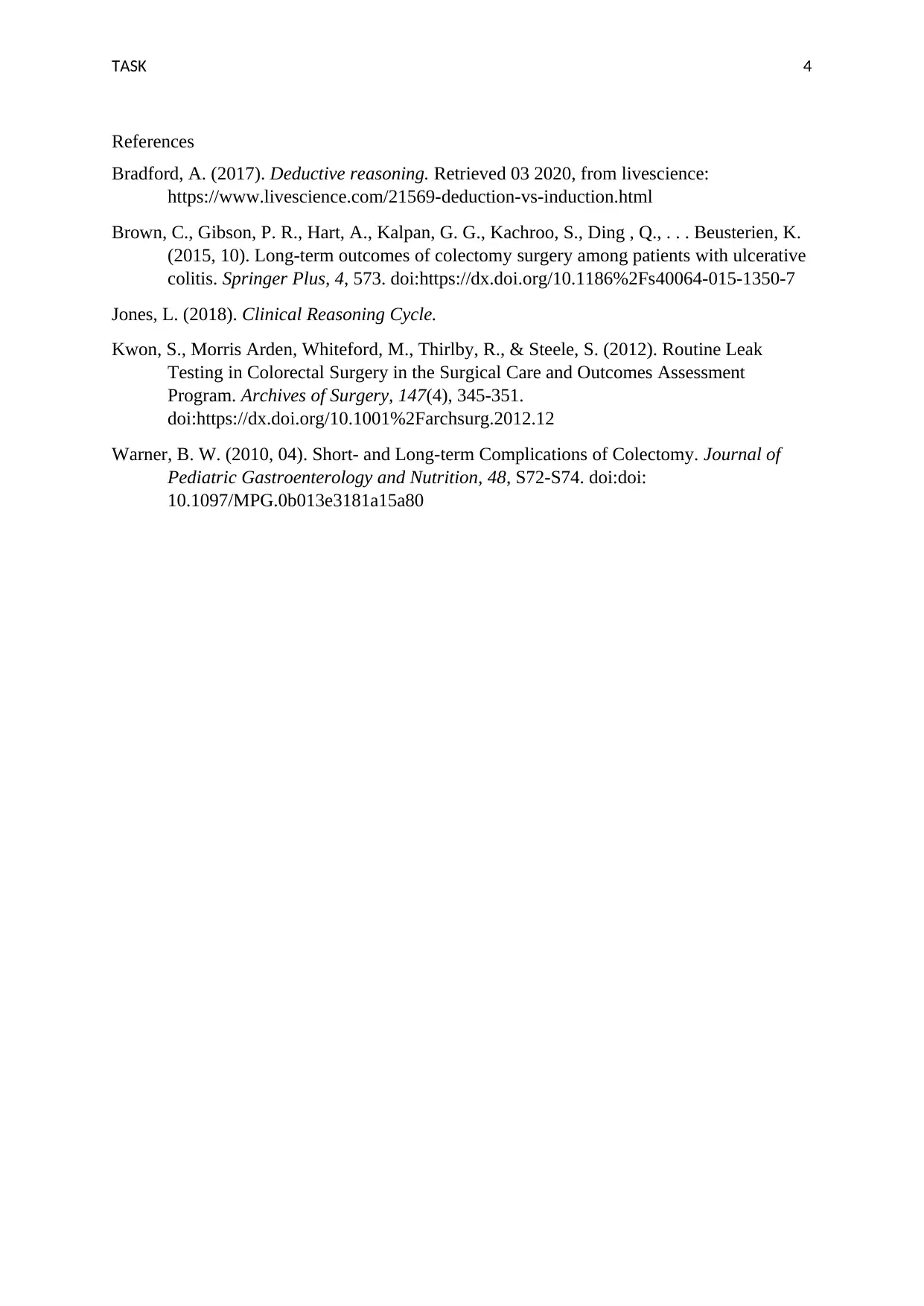Nursing Clinical Assessment and Diagnostic Reasoning: Task 2 Report
VerifiedAdded on 2022/08/22
|5
|760
|20
Report
AI Summary
This report presents a nursing clinical assessment of a patient named John, focusing on the application of the clinical reasoning cycle. The report details methods for gathering further information, including questions to ask, physical assessments, and diagnostic tests such as stool analysis, pathology tests, and imaging techniques like MRI and X-rays. John's immediate problems, such as sinus tachycardia and low blood pressure, and short-term problems, including potential complications like dehydration and ulcerative colitis, are identified. The report explains how the clinical reasoning cycle has been applied to analyze the patient's condition, comparing data to normal conditions and deducing outcomes from diagnostic details. References to relevant medical literature are included to support the analysis.

Running Head: TASK 0
Nursing
Clinical assessment and diagnostic reasoning
3-19-2020
Nursing
Clinical assessment and diagnostic reasoning
3-19-2020
Paraphrase This Document
Need a fresh take? Get an instant paraphrase of this document with our AI Paraphraser

TASK 1
Contents
Methods of gathering further information..................................................................................2
John’s immediate and short-term problems...............................................................................2
How clinical reasoning has been applied...................................................................................2
References..................................................................................................................................4
Contents
Methods of gathering further information..................................................................................2
John’s immediate and short-term problems...............................................................................2
How clinical reasoning has been applied...................................................................................2
References..................................................................................................................................4

TASK 2
Methods of gathering further information
Being a registered nurse and looking at the case of John there are several questions
regarding the dosage of the medication other than painkiller and the hypertension can be
asked, to evaluate its effect on the body. Stool analysis can be done, to check for the bleeding
post-operation. Pathology test can be performed to look for the bacteria Clostridium difficile
which would have caused the diarrhea. The MRI can be performed to look for the tumour in
the colon or abdomen area and to check the spread of cancerous cells. X-ray can be
performed under the supervision of a registered nurse to look for any wounds or the structure
of the organs in the colon to look for a tumour. Since it is a colon cancer it is very beneficial
to perform such tests. Testing of the colorectal anastomoses is done to look for higher
complications. Apart from this new intervention can be applied such as the use of laparotomy
by using the screening method of laparoscopy which give wider form of detail about the
condition in the abdominal region (Kwon, Morris Arden, Whiteford, Thirlby, & Steele,
2012).
John’s immediate and short-term problems
Sinus tachycardia is the immediate problem that can be observed clearly by looking at
his pulse rate as the normal pulse rate is between 60 to 100 beats per minute. This could be
due to the surgery and medication he is currently taking. Blood pressure of 109/50 indicates
that the diastolic pressure is low and can be reported as low blood pressure or hypotension. In
a study it was revealed that some patients had increased bowel movement and stool
frequency, so that can be the case with John as well (Brown, et al., 2015). Parallel with this it
can also cause dehydration and the medical condition hyponatremia. Ulcerative colitis is
another condition that can show up in following days due to irritants in the colon area and the
immune suppressive medication that is being consumed (Warner, 2010).
How clinical reasoning has been applied
Clinical Reasoning cycle has been applied in this study to gather new information and
to interpret the given data about the patient. It is then compared to the normal condition such
as the blood pressure is low and the pulse rate is high. Symptoms such as diarrhea and
constipation which cannot be ignored as these basic symptoms resulted in the colon cancer.
The irrelevant information involved the visit of family and friends. It can be inferred that he
already had a blood pressure issue and was on medication for the same. It can be deduced that
the person had gone through the operation for treating the colon cancer, which resulted in
Methods of gathering further information
Being a registered nurse and looking at the case of John there are several questions
regarding the dosage of the medication other than painkiller and the hypertension can be
asked, to evaluate its effect on the body. Stool analysis can be done, to check for the bleeding
post-operation. Pathology test can be performed to look for the bacteria Clostridium difficile
which would have caused the diarrhea. The MRI can be performed to look for the tumour in
the colon or abdomen area and to check the spread of cancerous cells. X-ray can be
performed under the supervision of a registered nurse to look for any wounds or the structure
of the organs in the colon to look for a tumour. Since it is a colon cancer it is very beneficial
to perform such tests. Testing of the colorectal anastomoses is done to look for higher
complications. Apart from this new intervention can be applied such as the use of laparotomy
by using the screening method of laparoscopy which give wider form of detail about the
condition in the abdominal region (Kwon, Morris Arden, Whiteford, Thirlby, & Steele,
2012).
John’s immediate and short-term problems
Sinus tachycardia is the immediate problem that can be observed clearly by looking at
his pulse rate as the normal pulse rate is between 60 to 100 beats per minute. This could be
due to the surgery and medication he is currently taking. Blood pressure of 109/50 indicates
that the diastolic pressure is low and can be reported as low blood pressure or hypotension. In
a study it was revealed that some patients had increased bowel movement and stool
frequency, so that can be the case with John as well (Brown, et al., 2015). Parallel with this it
can also cause dehydration and the medical condition hyponatremia. Ulcerative colitis is
another condition that can show up in following days due to irritants in the colon area and the
immune suppressive medication that is being consumed (Warner, 2010).
How clinical reasoning has been applied
Clinical Reasoning cycle has been applied in this study to gather new information and
to interpret the given data about the patient. It is then compared to the normal condition such
as the blood pressure is low and the pulse rate is high. Symptoms such as diarrhea and
constipation which cannot be ignored as these basic symptoms resulted in the colon cancer.
The irrelevant information involved the visit of family and friends. It can be inferred that he
already had a blood pressure issue and was on medication for the same. It can be deduced that
the person had gone through the operation for treating the colon cancer, which resulted in
⊘ This is a preview!⊘
Do you want full access?
Subscribe today to unlock all pages.

Trusted by 1+ million students worldwide

TASK 3
colectomy which means removal of the colon and another organ in the abdominal area. It is a
deductive method in which the journal and scientific records were studied to reach the
outcomes from the diagnostic details that are being presented (Bradford, 2017).
colectomy which means removal of the colon and another organ in the abdominal area. It is a
deductive method in which the journal and scientific records were studied to reach the
outcomes from the diagnostic details that are being presented (Bradford, 2017).
Paraphrase This Document
Need a fresh take? Get an instant paraphrase of this document with our AI Paraphraser

TASK 4
References
Bradford, A. (2017). Deductive reasoning. Retrieved 03 2020, from livescience:
https://www.livescience.com/21569-deduction-vs-induction.html
Brown, C., Gibson, P. R., Hart, A., Kalpan, G. G., Kachroo, S., Ding , Q., . . . Beusterien, K.
(2015, 10). Long-term outcomes of colectomy surgery among patients with ulcerative
colitis. Springer Plus, 4, 573. doi:https://dx.doi.org/10.1186%2Fs40064-015-1350-7
Jones, L. (2018). Clinical Reasoning Cycle.
Kwon, S., Morris Arden, Whiteford, M., Thirlby, R., & Steele, S. (2012). Routine Leak
Testing in Colorectal Surgery in the Surgical Care and Outcomes Assessment
Program. Archives of Surgery, 147(4), 345-351.
doi:https://dx.doi.org/10.1001%2Farchsurg.2012.12
Warner, B. W. (2010, 04). Short- and Long-term Complications of Colectomy. Journal of
Pediatric Gastroenterology and Nutrition, 48, S72-S74. doi:doi:
10.1097/MPG.0b013e3181a15a80
References
Bradford, A. (2017). Deductive reasoning. Retrieved 03 2020, from livescience:
https://www.livescience.com/21569-deduction-vs-induction.html
Brown, C., Gibson, P. R., Hart, A., Kalpan, G. G., Kachroo, S., Ding , Q., . . . Beusterien, K.
(2015, 10). Long-term outcomes of colectomy surgery among patients with ulcerative
colitis. Springer Plus, 4, 573. doi:https://dx.doi.org/10.1186%2Fs40064-015-1350-7
Jones, L. (2018). Clinical Reasoning Cycle.
Kwon, S., Morris Arden, Whiteford, M., Thirlby, R., & Steele, S. (2012). Routine Leak
Testing in Colorectal Surgery in the Surgical Care and Outcomes Assessment
Program. Archives of Surgery, 147(4), 345-351.
doi:https://dx.doi.org/10.1001%2Farchsurg.2012.12
Warner, B. W. (2010, 04). Short- and Long-term Complications of Colectomy. Journal of
Pediatric Gastroenterology and Nutrition, 48, S72-S74. doi:doi:
10.1097/MPG.0b013e3181a15a80
1 out of 5
Related Documents
Your All-in-One AI-Powered Toolkit for Academic Success.
+13062052269
info@desklib.com
Available 24*7 on WhatsApp / Email
![[object Object]](/_next/static/media/star-bottom.7253800d.svg)
Unlock your academic potential
Copyright © 2020–2025 A2Z Services. All Rights Reserved. Developed and managed by ZUCOL.





